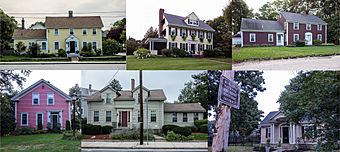Rumford, Rhode Island facts for kids
|
Rumford Historic District
|
|
 |
|
| Location | Pleasant St. and Greenwood and Pawtucket Aves, East Providence, Rhode Island |
|---|---|
| Area | 150 acres (61 ha) |
| Architectural style | Queen Anne, Shingle Style |
| MPS | East Providence MRA |
| NRHP reference No. | 80000008 (original) 100002778 (increase) 100002777 (decrease) |
Quick facts for kids Significant dates |
|
| Added to NRHP | November 28, 1980 |
| Boundary increase | August 6, 2018 |
| Boundary decrease | August 6, 2018 |
Rumford is a cool neighborhood located in the northern part of East Providence, Rhode Island. It's right next to Seekonk, Massachusetts, Pawtucket, Rhode Island, and the Ten Mile River (Seekonk River). Rumford has an interesting past! It used to be part of different towns and even different states.
It was once part of Rehoboth and Seekonk, Massachusetts. Then, in 1862, it officially became part of Rhode Island. You might have heard of Rumford Baking Powder. It was made here at the Rumford Chemical Works. The powder was named after a famous scientist, Sir Benjamin Thompson, also known as Count Rumford.
Discovering Rumford's History
Rumford is a special place with a lot of history. About 150 acres of the area are listed on the National Register of Historic Places. This means it's recognized for its important buildings and history.
A Place with Old Roots
This historic area includes the very old center of what was once Seekonk. It also covers the main part of East Providence from the 1800s. Walking through Rumford is like taking a step back in time. You can see buildings from the 19th century.
Famous Golf Course
In 1898, the Wannamoisett Country Club was started in Rumford. It was built on land rented from the Rumford Chemical Works. This club is very famous for golf.
Every year, it hosts a big golf competition called the Northeast Amateur Invitational Golf Tournament. Also, a major championship, the 1931 PGA Championship, was played here. It's a really important spot for golf fans!
Images for kids
-
First Baptist Church, designed by William Walker






